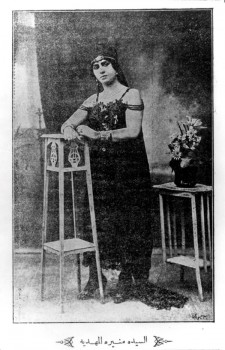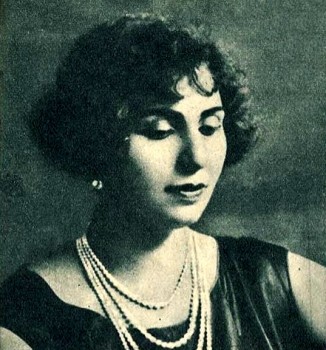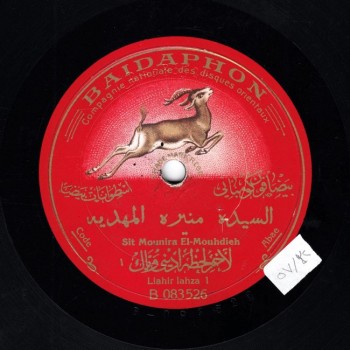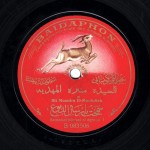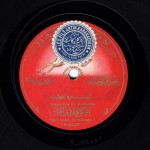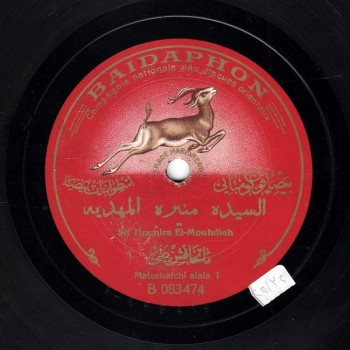 The Arab Music Archiving and Research foundation (AMAR), in collaboration with the Sharjah Art Foundation (SAF), presents “Min al-Tārīkh”.
The Arab Music Archiving and Research foundation (AMAR), in collaboration with the Sharjah Art Foundation (SAF), presents “Min al-Tārīkh”.
Dear listeners,
Welcome to a new episode of “Min al-Tārīkh”.
Today, we will resume our discussion about Sitt Munīra al-Mahdiyya with Prof. Frédéric Lagrange.
We had started talking about Sitt Munīra the takht muṭriba.
We started with the dawr at the end of the waṣla. Now, let us talk about her creative genius’ performance of mawwāl.
Her performance of mawwāl was, strangely, a genius’ performance. And, even stranger, she only recorded two mawwāl.
Not only was she a genius in her performance of mawwāl, her style was also beautiful and unique… She would be a Zaynab al-Manṣūriyya if she sang with a takht.
You mean that there was a hint of baladī in her interpretation.
Right.
… Something between secular singing and baladī singing, or maybe the missing link between these two styles.
Exactly. What do you think?
…It is very possible indeed.
“In Kāna ‘adhābī” is the most beautiful mawwāl she ever sang.
A little shūrī…
(♩)
Her ṭaqṭūqa are different from those recorded by ‘ālima before WW1.
It seems that Baidaphon became her exclusive sponsor after WW1 before which she had recorded with Zonophone, Bekka, and Odeon. So either Baidaphon started sponsoring her in 1914, then stopped recording, then came back and recorded again; or they became her sponsors after they started recording again after WW1… right?
Exactly.
The ṭaqṭūqa Munīra al-Mahdiyya sang in the 1920s were all made under record companies who, before WW1, recorded the musical forms present on the Egyptian musical scene. After that, the record industry imposed a new form that kept the appellation ṭaqṭūqa but whose content was different… the same name for a different form.
First, the new form included 4 ghuṣn, not 7, 8, or 10 as before.
As long as the disc’s length.
Exactly.
The melody is deeper, not as simple, and more evolved…
…Because there is a composer, an author, and because the ṭaqṭūqa is recorded.
“Recorded ṭaqṭūqa” refers to the commercially recorded ṭaqṭūqa, including copyrights and artistic categorization.
Munīra al-Mahdiyya’s ṭaqṭūqa are either ordinary love ṭaqṭūqa, or deal with social issues. She sometimes performed as a playful young girl, such as in one of her most famous ṭaqṭūqa “Mā tkhafshi ‘alayya ana waḥda sigūriā”.
…For example… or “Li-ākhir laḥẓa iddīnī wayyāk”.
And “Li-ākhir laḥẓa iddīnī wayyāk”, let us listen to these two in a row.
Why not?…
(♩)
By the way, Munīra al-Mahdiyya’s love ṭaqṭūqa recorded by Baidaphon in 1922 include a ṭaqṭūqa to the bastanikār that ‘Abd al-Ḥalīm Ḥāfiẓ hinted at in “Yā sīdī amrak”…
Yes. He also hinted at “Wa-ḥaqqak ant” and at dawr “Fī al-bu‘di yāmā”.
…It is ṭaqṭūqa “Ḥubbak yā sīdī ghaṭṭa ‘a-el-kull”, one of Al-Qaṣṣabjī’s first compositions, I think.
True.
Second, the maqām is the bastanikār, very rarely used in dawr and in ṭaqṭūqa.
Yet both Munīra al-Mahdiyya and Abd al-Ḥalīm Ḥāfiẓ dealt with it superbly.
And the melody in marvellously beautiful.
‘Abd al-Ḥalīm Ḥāfiẓ dared to mock Munīra al-Mahdiyya! Maybe the famous photograph of them together was taken when he went to apologize to her… Such a touching photograph reuniting two singers from two different eras, representing two totally separate phases in the history of Arab Music.
Almost all literary/classical Arab songs in most musical films made from the late 1940s up to the mid-1960s include some mockery.
He also mocked some pieces Umm Kulthūm sang, such as “Wa-ḥaqqak ant al-muna w-al-ṭalab”. Yet I do not think Umm Kulthūm resented him for this.
Mostly, there was an implicit understanding/agreement to mock this repertoire… even ‘Azīz ‘Uthmān mocked his father.
For example.
…Or himself.
Munīr Murād also mocked his father.
Exactly, exactly…
(♩)
Dear listeners, we have reached the end of today’s episode of “Min al-Tārīkh”.
We thank Prof. Frédéric Lagrange.
We will meet again in a new episode to resume our discussion about Sitt Munīra al-Mahdiyya.
“Min al-Tārīkh” is brought to you by Mustafa Said.
- 221 – Zakariyya Ahmed – 12 (1/9/2022)
- 220 – Zakariyya Ahmed – 11 (1/9/2022)
- 219 – Zakariyya Ahmed – 10 (11/25/2021)
- 218 – Zakariyya Ahmed – 9 (10/26/2021)
- 217 – Zakariyya Ahmed – 8 (9/24/2021)
- 216 – Zakariyya Ahmed – 7 (9/4/2021)
- 215 – Zakariyya Ahmed – 6 (8/28/2021)
- 214 – Zakariyya Ahmed – 5 (8/6/2021)
- 213 – Zakariyya Ahmed – 4 (6/26/2021)
- 212 – Zakariyya Ahmed – 3 (5/27/2021)
- 211 – Zakariyya Ahmed – 2 (5/1/2021)
- 210 – Zakariyya Ahmed – 1 (4/28/2021)
- 209 – W-al-Lāhi lā astaṭī‘u ṣaddak 2 (4/6/2017)
- 208 – W-al-Lāhi lā astaṭī‘u ṣaddak 1 (3/30/2017)
- 207 – Bashraf qarah baṭāq 7 (3/23/2017)

